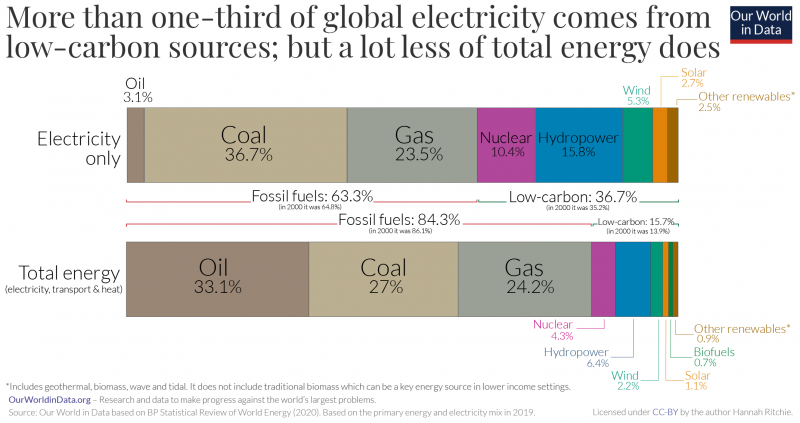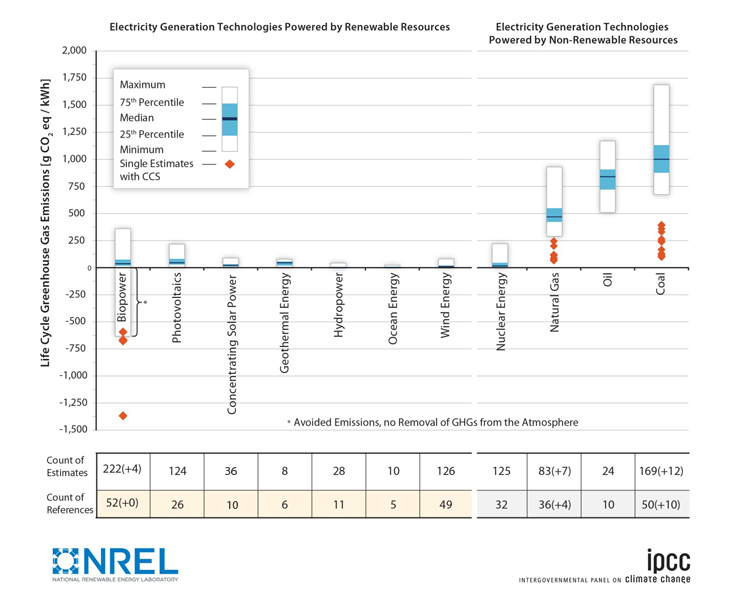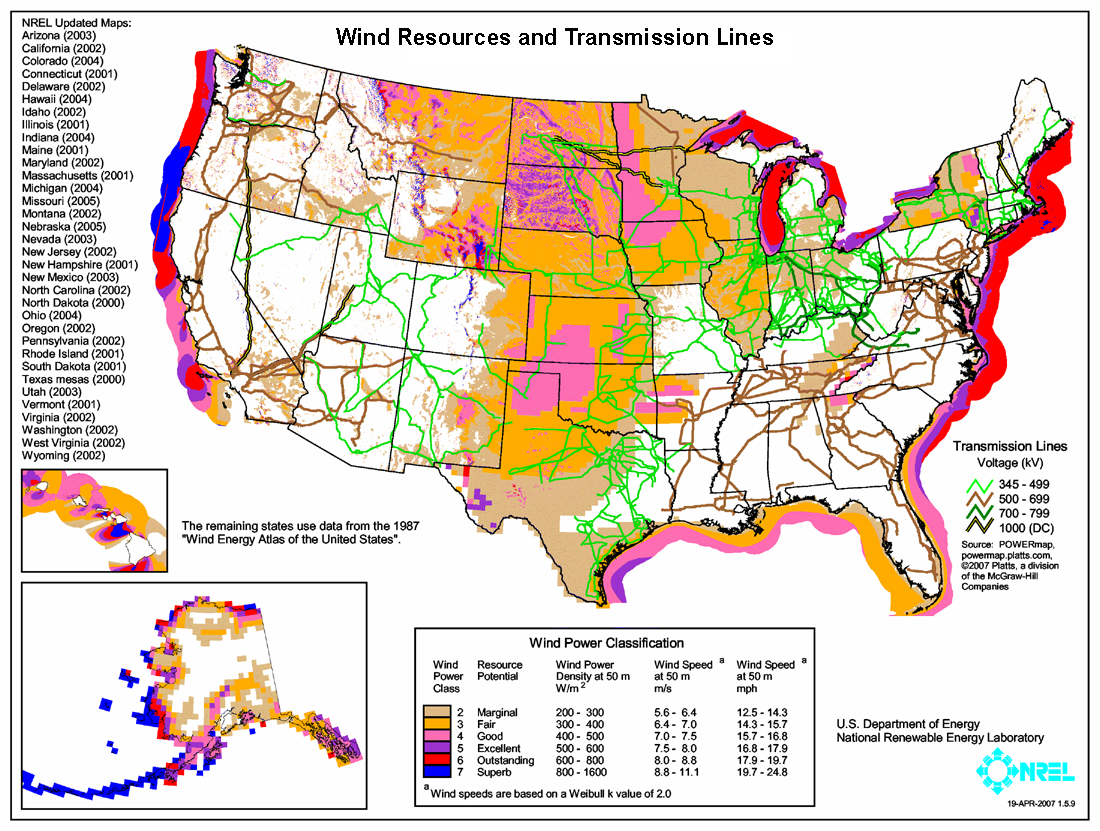Learning Objectives Self-Check
Read through the following statements/questions. You should be able to answer all of these after reading through the content on this page. I suggest writing or typing out your answers, but if nothing else, say them out loud to yourself.
Given the scope of this lesson and course, I will limit the focus of this page to the three most prominent renewable electricity technologies: solar photovoltaic, wind, and hydroelectricity.
Supply and Feasibility
I've combined these two sections into one because the supply aspect is very straightforward for wind and solar: they are inexhaustible! As stated in Lesson 1, both of them get their energy from the sun, and if the sun stops shining we have more important issues to deal with than not having a source of renewable electricity. The amount of solar energy that hits the earth in about one hour is enough to power the world for an entire year (this is a commonly held fact, but here is one source from Sandia National Laboratories). There is no shortage of solar energy!
As for hydroelectric, though it also gets its energy from the sun, it is limited due to its dependence on the availability of flowing water. As of 2021, about 15% of the world's electricity came from hydroelectricity. According to the International Energy Agency, there is about 5 times as much technical potential for hydroelectric worldwide as is currently generated today. We certainly would not want to exploit all of it, given some of the environmental impacts of large hydroelectric facilities (see below), but this number does provide a frame of reference.

The feasibility is a mixed bag. An oft-cited paper by Mark Jacobsen and Mark Delucchi of Stanford University showed that through wind, water (hydroelectricity), and solar, all of the world's energy needs could be met by 2030, or in a less aggressive scenario, 2050 (note that this is all energy, not just electricity). This assumes that energy efficiency would increase worldwide by 5% - 15%. According to their research, this could be done using existing technologies and would require the use of about 1% of all dry land on earth. They assert that the barriers to accomplish this are "social and political, not technological and economic." They calculate that it would cost $100 trillion over a 20 year period. There are a lot of other details to this study - way too many to get into here.
There are no shortage of critiques to this study, including this critique from Ted Trainer of the University of New South Wales, who is an advocate of renewable energy. He cites possible underestimates in their cost calculation, underestimates of the amount of energy required to provide a high quality of life (the authors assume that the per person energy use in 2050 would be about 1/6th of the current per person energy use in Australia, for example), and probably overestimate the reasonableness of electric storage capacity, among other things. If nothing else, this plan would require an alteration to the global energy infrastructure at a pace and scale that has never been seen before. It is almost certainly possible with enough political and social will, but it would take a lot of both.
One sign that bodes well for renewables is that the cost has come down significantly in recent years. In the U.S. the cost of generating electricity from wind and hydroelectric - assuming they are sited and installed properly - is cost-competitive with fossil fuels, even without incentives. Residential-scale solar is still relatively expensive, but utility-scale (large arrays) are cost competitive today. This is all based (as you will see below) on the levelized cost of electricity (LCOE), which was noted in the nuclear lesson. The LCOE is the amount it costs to generate each unit of energy (usually measured in $/megawatt-hour) on average over the lifetime of an electricity source.
Levelized Cost of Energy (LCOE): the amount it costs to generate each unit of energy (usually measured in $/megawatt-hour) on average over the lifetime of an electricity source.
This includes everything from building the power plant (e.g. nuclear plant, solar array, wind turbine), to purchasing the energy source (e.g. coal, natural gas), to operating the plant, to decommissioning the plant at the end of its life. To calculate the LCOE, you take the total lifecycle costs and divide it by the total electricity output over the lifetime of the source. This is of course not including externalities, which would likely make renewable energy cheaper right now, especially if the social cost of carbon were to be considered.
| electricity source | low | high |
|---|---|---|
| rooftop solar PV | $117 | $282 |
| community and commercial/industrial PV | $49 | $185 |
| utility-scale PV | $24 | $96 |
| utility-scale PV + storage | $46 | $102 |
| geothermal | $61 | $102 |
| onshore wind | $24 | $75 |
| onshore wind + storage | $42 | $114 |
| offshore wind | $72 | $140 |
| peaking gas | $115 | $221 |
| nuclear | $141 | $221 |
| coal | $68 | $166 |
| gas combined cycle | $39 | $101 |
To Read Now
- Browse through "Wind and Solar Are Our Cheapest Electricity Generation Sources. Now What Do We Do?" Michael O'Boyle, Greentech Media. You only need to read until you hit the "How can this impact overall system costs?" subheading. This article is from 2017, but the cost of most renewables has only gotten cheaper since then, as you'll see if you read the optional article below.
- (Optional) "Renewables were the world’s cheapest source of energy in 2020, new report shows" World Economic Forum, July 2021.
- (Optional) "Plunging Renewable Energy Prices Mean U.S. Can Hit 90% Clean Electricity By 2035 - At No Extra Cost." Forbes.
- (Optional) "Renewable Electricity Levelized Cost Of Energy Already Cheaper Than Fossil Fuels, And Prices Keep Plunging." Energy Innovation.
- (Optional) "Wind and Solar Energy Technologies Eat Into Fossil Fuel Power's Business Plan." Mike Stott, Forbes.
The bottom line in terms of cost is that right now, well-sited wind and utility scale solar ("utility scale" refers to large arrays, usually hundreds or thousands of panels in size) are the cheapest form of electricity available, other than only the least expensive natural gas power plants. (Please note that, as stated in a previous lesson and the Greentech Media article above, energy efficiency is cheaper than all energy sources!) Other renewable sources such as small hydroelectric, biomass, geothermal, solar thermal, and commercial-scale solar are very cost-competitive with coal and natural gas, and generally less expensive than nuclear. All of this does NOT include subsidies, by the way!
Sustainability Issues
All three of these sources are considered carbon-free, so they are ideal with regards to anthropogenic climate change. Even after consideration of the embodied energy of these sources - hydroelectric dams require a LOT of concrete; solar panels are manufactured in an energy-intensive process, as are wind turbines; and all of them require mining - the lifecycle carbon footprint is minimal for renewables, as you can see in the chart below. In terms of climate change concern, there is really no debate: these renewables are great choices.

However, there are some other considerations to make in terms of sustainability. First, large hydroelectric facilities are not very environmentally friendly. Depending on the location, there can be problems with flooding of habitats and even towns, compromising fish migration, altering stream content and temperature, impacting scenic areas, and other considerations. The articles below provide some insight into some of these potential problems. Note also that not all hydro has the same problems - by using different types of hydroelectric facilities such as run-of-the-river and microhydro, environmental and social impacts can be minimized.
To Read Now
- "Hydropower Explained: Hydropower and the Environment." U.S. EIA.
- "China Admits Problems with Three Gorges Dam." Michael Wines, New York Times (link to PDF).
- "Run-of-river hydro, Indonesia." (Video)
- "Solar Power Explained: Solar Energy and the Environment." U.S. EIA
- "Environmental Impacts of Wind Power." Union of Concerned Scientists.
In terms of social equity, there are a few important considerations to make. First of all, do people have access to energy, and can they afford it? This is a tricky question to answer, as it depends on a lot of factors, many of which were indicated above. Some equity and other considerations include:
- Solar panels used to be prohibitively expensive, but new business models are making them much more affordable, even effectively free to the customer. See for example community solar and power purchase agreements.
- Wind and hydro can usually be purchased through utilities at the same or lower rates than fossil fuels.
- One very important equity consideration is that fossil fuel power plants are often sited near low-income areas of the country and world, and thus the negative health impacts are unevenly distributed, with the least powerful bearing the brunt. (The term "environmental justice" hopefully comes to mind for you right about now!) Add to the previous point that the environmental destruction from coal mining is especially unevenly distributed.
- Wind turbines can be a nuisance, as indicated in the article above, but is relatively minor compared to power plants.
- Solar is usually unobtrusive, though some people do not like "the look" of the panels.
- Large hydro can have a major social cost, as you saw in the article above. Flooding of houses and even whole towns can result from dams being built, though this is more the exception than the rule in industrialized countries. As always, these impacts are disproportionately felt by low income and marginalized people.
One of the benefits of conventional energy generation is that the infrastructure is largely set up, at least in industrialized countries. In the U.S., for over 100 years, we have built an energy infrastructure based on large power plants and fossil-fuel based vehicles. This gives conventional energy sources an advantage in terms of providing access. That said, wind, hydro, and solar can all utilize the existing infrastructure. Hydroelectric dams provide the same service as fossil-fuel power plants, but usually on a slightly smaller scale, so they are a good fit. They also provide a very consistent stream of electricity as long as no droughts are occurring, and they can increase and decrease production pretty rapidly, unlike solar and wind.
Probably the biggest current problem with solar and wind is that they are intermittent - the sun does not always shine and the wind does not always blow. This is a major issue because we currently do not yet have widespread storage capabilities to provide the energy on demand, though improving battery technology and policy are rapidly changing that. As you can see in figre 4.21, solar and wind plus storage are now cost-competitive with fossil fuels, and costs continue to drop. This has resulted in some utilities agreeing to purchase or build "solar + storage" facilities because it makes economic sense. For the sam reasons, multiple "wind + storage" facilities were online as of 2020. The future of renewables is in storage! (Side note: If any of you discover an energy dense, cheap storage medium that is abundant and safe, feel free to give me a cut of your billions of dollars in wealth!)
One common problem with wind and solar are that they are often highest in areas with low population densities. In the U.S., for example, the greatest onshore wind resources are in the Great Plains in the Midwest, where the population density is very low. Because of this, a lot of infrastructure (high voltage power lines for example) will need to be added to fully tap into these resources. That said, as you can see in the map below, offhore wind resources match up pretty well with heavily populated areas. However, offshore wind is currently expensive.

One of the benefits of solar is that as long as there is not too much shading, many households can satisfy their energy needs using existing rooftop spaces. However, not every location is ideal for solar.
Summary
Overall, the biggest advantages of renewable energy are:
- they are inexhaustible (hydro has limits);
- they are effectively carbon free;
- they have very minimal environmental impacts (notwithstanding large hydro);
- they also tend to be more democratic, in that many of them are suitable for scaling down to a personal level. This is not possible with current technology for fossil fuel-based electricity generation;
- most of them are also cheaper than almost all forms of non-renewable energy.
The main disadvantages of solar, wind, and hydro are:
- solar and wind are intermittent, and so without storage cannot be relied upon to deliver energy when needed;
- they are not able to be deployed in every location, e.g., shaded areas for solar, calm areas for wind, and dry areas for hydro;
- large-scale hydro has a lot of negative environmental impacts, and there are some environmental and social problems with wind.
The last things I'd like to note are the following:
- Regardless of any other sustainability considerations, as noted in the beginning of this lesson, the world's energy (not just electricity!) must come from carbon free sources relatively soon if we are to avoid climate catastrophe. Remember - we must be carbon neutral by around 2050 is the goal to limit warming to 1.5 C!
- The most sustainable energy is the energy that you don't use. Remember that energy efficiency is sometimes called the "fifth fuel?" That is very much applicable to these considerations. Also, as noted above, energy efficiency has been found to have a lower LCOE than any other energy source! The more we can reduce our energy use while getting the same benefits from the energy service, the better off we will be.
Check Your Understanding
Optional (But Strongly Suggested)
Now that you have completed the content, I suggest going through the Learning Objectives Self-Check list at the top of the page.